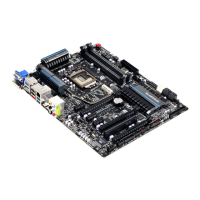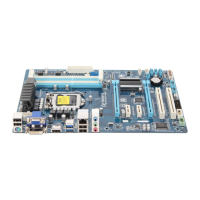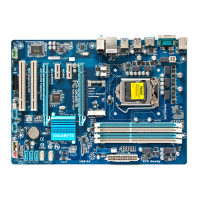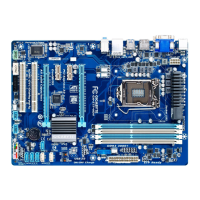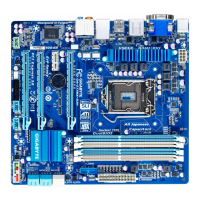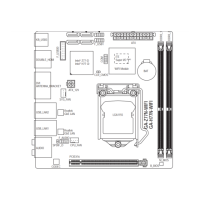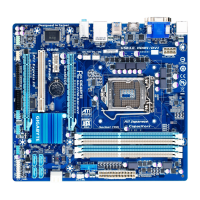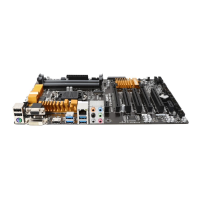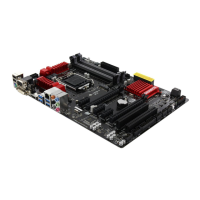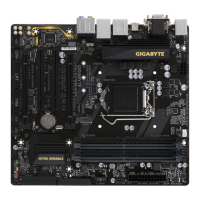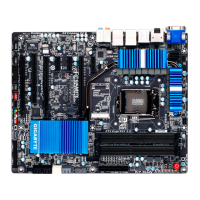
Do you have a question about the Gigabyte GA-Z77X-UD5H and is the answer not in the manual?
| ECC | No |
|---|---|
| Non-ECC | Yes |
| Memory voltage | 1.5 V |
| Memory channels | Dual-channel |
| Memory slots type | DIMM |
| Number of memory slots | 4 |
| Supported memory types | DDR3-SDRAM |
| Maximum internal memory | 32 GB |
| Supported memory clock speeds | 1066, 1333, 1600 MHz |
| Supported memory module capacities | 16GB, 1GB, 2GB, 4GB, 8GB |
| System bus rate | 5 GT/s |
| Processor socket | LGA 1155 (Socket H2) |
| Processor manufacturer | Intel |
| Compatible processor series | Intel Core i3, Intel Core i5, Intel Core i7 |
| Maximum number of SMP processors | 1 |
| USB 2.0 connectors | 2 |
| Number of SATA III connectors | 5 |
| Number of Parallel ATA connectors | 0 |
| USB 3.2 Gen 1 (3.1 Gen 1) connectors | 3 |
| Headphone outputs | 6 |
| USB 2.0 ports quantity | USB 2.0 ports have a data transmission speed of 480 Mbps, and are backwards compatible with USB 1.1 ports. You can connect all kinds of peripheral devices to them. |
| Audio chip | Realtek ALC898 |
| Cooling type | Passive |
| Component for | PC |
| Motherboard chipset | - |
| PC health monitoring | CPU, FAN, Temperature |
| Audio output channels | 7.1 channels |
| Motherboard form factor | ATX |
| Compatible operating systems | Windows 7/XP |
| RAID levels | 0, 1, 5, 10 |
| Supported storage drive interfaces | SATA II, SATA III |
| Cables included | SATA |
| Graphics card | HD Graphics |
| OpenGL version | 3.2 |
| DirectX version | 11 |
| Maximum graphics card memory | 1696 MB |
| Parallel processing technology support | 2-Way CrossFireX, 2-Way SLI, LucidLogix Virtu |
| PCI Express slots version | 2.0, 3.0 |
| PCI Express configurations | 1x4, 1x8, 1x16 |
| Controller interface type | Intel Z77 |
| Controller 2nd interface type | 2 x Marvell 88SE9172 |
| Wi-Fi standards | Not supported |
| Networking features | 10/100/1000 Mbit/sec |
| Ethernet interface type | Gigabit Ethernet |
| BIOS type | EFI AMI |
| ACPI version | 2.0a |
| BIOS memory size | 64 Mbit |
| Depth | 244 mm |
|---|---|
| Width | 305 mm |
Describes the types of documentation provided for the product.
Explains how to find and interpret the motherboard revision number.
Lists all items included in the motherboard package.
Lists additional accessories that can be purchased.
Essential guidelines and safety measures before installation.
Detailed steps for correctly seating the CPU in its socket.
Explanation of setting up memory for dual-channel operation.
Specific steps for installing a PCI Express graphics card.
Prerequisites and physical connection for SLI/CrossFireX.
Details on connecting displays via video ports.
Functionality of power, reset, CMOS buttons, and BIOS switch.
Numbered list and location of internal connectors.
Introduction to BIOS and how to enter setup.
Displays current system performance data like frequencies and temperatures.
Settings for power phase control and voltage response time.
Configuration for detecting chassis cover removal.
Configuring system language and clock settings.
Defining the boot order for devices.
Configuration for FireWire and LAN boot options.
Configuration of power states and saving features.
Options for saving changes, exiting, and loading defaults.
Steps for installing essential chipset drivers.
Utility for system backup and restoration.
Overview of EasyTune's tabs and functions.
Instructions for setting up and using data sharing.
Steps to configure RAID 0 arrays for performance.
Steps to set up power saving modes based on phone presence.
Steps to create the necessary partition on an SSD.
Steps to set up the technology via registry editing.
Steps to set up SSD caching for faster data access.
Guide to SATA drive setup, including RAID levels.
Steps for configuring 2/4/5.1/7.1 channel audio.
Enabling EAX effects for enhanced gaming audio.
Answers to common user queries about the motherboard.
LED codes displayed during normal system startup.
Details on hazardous substances and waste directives.
Instructions for accessing the online support portal.

